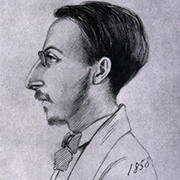Early in his career Saint-Saëns composed his Oratorio de Noël, an easily accessible work which is now available in an authoritative Urtext edition.
Camille Saint-Saëns (1835–1921) was just 23 years old when he composed the first six movements of his Oratorio de Noël in a few days in December 1858. It received its first performance, probably at Midnight Mass, in the church of La Madeleine in Paris. He added four further movements over the following five years. When exactly, and above all, why Saint-Saëns composed these movements later, cannot be determined from the sources. It is conceivable that after the premiere, he elaborated some ideas which he had not been able to complete in the short period of time available in 1858. But it is also possible that the movements were written in stages for three performances over the following years, in order to be able to offer something new each time. Perhaps the large-scale version was even planned from the outset so as to give the work a different kind of importance. But he only undertook a systematic revision of the original version much later.
Some considerable time later, Saint-Saëns expressed how he felt about the first performance of the work in 1858; he was apparently very pleased with it, particularly with the “superstars” – as he described them – who sang the solo parts. By contrast, the performance was not reviewed in the press, probably because the work did not correspond with the taste of the time: Paris in the 1850s breathed the spirit of music theatre, and in the liturgical realm, at Christmas it was compilations of well-known Christmas carols (Noëls) which had been arranged into suites or cantatas with different scorings which had long dominated.
Inspired by the reception Beethoven’s music received, there was a great fondness for German music in France at this time, especially that of Johann Sebastian Bach. Even though Saint-Saëns decisively rejected this fashion much later on, he nevertheless shared the interest in German instrumental music. His love of the works of Bach is reflected in transcriptions of some of the cantata and sonata movements for piano, amongst others. Significantly, these were made around the same time as the Oratorio de Noël.
The parallels between Saint-Saëns’ composition and Bach’s Christmas Oratorio are clear, not just because of the subtitle on the first page of the printed score (“Dans le style de Séb. Bach”).
In contrast with Bach, the Christmas story in Saint-Saëns’ version is not narrated by an evangelist, rather the French composer divides the accounts between different soloists. Saint-Saëns also set no special texts: he used exclusively texts from the Vulgate and the Catholic liturgy.
The work only became widely available five years after the premiere when a vocal score of the Oratorio de Noël by Saint-Saëns’ pupil Eugène Gigout was published by Gustave Flaxland (the future Durand company). It is interesting that for almost the next 30 years there was neither a printed edition of the full score nor the orchestral parts. Only in 1892 was the score printed by Durand. The large print-runs of the choral parts and the vocal score indicate that the work was incredibly popular. In later years Saint-Saëns himself described this early work as his “petit oratorio de noël”. It may be a small work, but it is very effective, so that it is attractive both for small choirs as well as larger ensembles. And even now it remains extremely popular worldwide.
For the first time, the work is now available in a comprehensive scholarly-critical Urtext edition, not only documenting the composer’s reworkings, but also giving valuable hints about the Gallic pronunciation of the Latin text which was typically used in France until 1903.
The vocal score is based on the contemporary arrangement by Gigout.
Christina M. Stahl
(from [t]akte 1/2020 – translation: Elizabeth Robinson)



